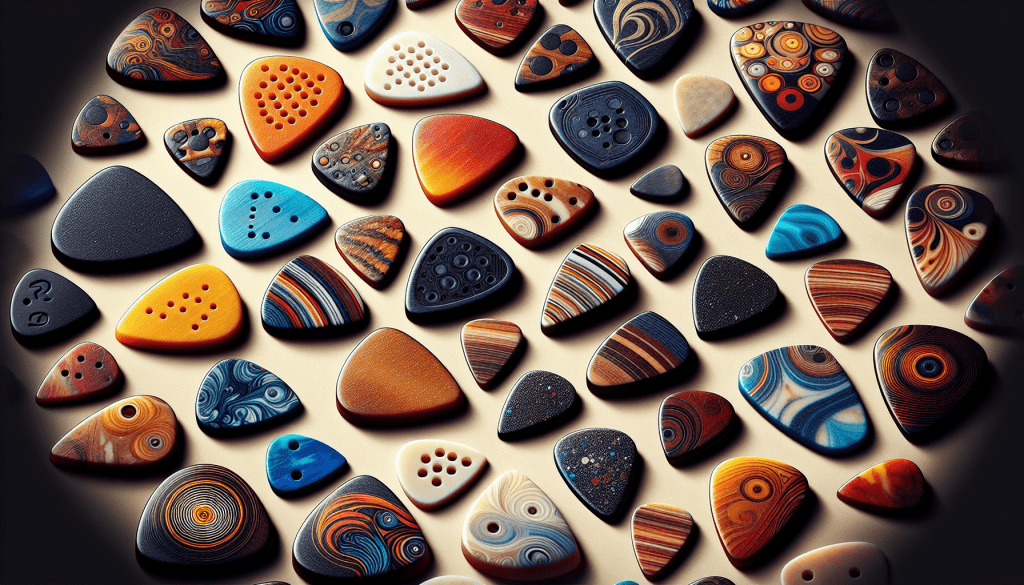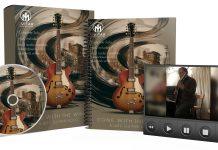This post may contain affiliate links. As an Amazon associate, Google associate as well as associate for other programs, Guitar & Music Institute may earn commissions from qualifying purchases.

Have you ever wondered how the type of guitar pick you use can actually impact the tone of your guitar sound? In this article, we hope to shed some light on this aspect of playing the guitar. From the material and thickness to the shape and texture, each pick has its own unique characteristics that can alter the sound produced by your guitar strings. So, read on to discover the secrets behind different tones by simply choosing different picks.
Introduction
The type of pick you use can affect the tone, attack, sustain, and overall feel of your playing. With so many different options available, it’s essential to understand the various types of guitar picks and how they impact your sound. In this article, we explore the different types of guitar picks, the materials used to make them, and the effects of pick thickness, shape, material, and grip texture. We also discuss various techniques to enhance different pick effects. So, let’s dive in and learn how picks alter your sound in so many ways.
Types of Guitar Picks
Standard Picks
Standard picks, also known as medium picks, are the most commonly used picks among guitarists. They offer a balanced feel and a versatile tone that works well for both strumming and picking. Standard picks are a great starting point for beginners as they provide a neutral sound that suits various playing styles.
Thin Picks
Thin picks are characterized by their flexibility and lightness. They produce a bright and jangly tone, making them ideal for strumming chords on acoustic guitars. Thin picks also allow for fast picking with less resistance, enabling quick and precise movements across the strings. However, they may lack the volume and control needed for heavy rhythm playing or lead solos. Thin picks are often the first choice of beginners, however, it would be best to get used to thicker picks as they help you have more control over the dynamic of stoke across the strings.
Thick Picks
Thick picks, on the other hand, offer a more substantial and rigid feel. They are preferred by guitarists who seek a bold and robust tone. Thick picks are excellent for generating fat and powerful sounds while providing increased control and precision. They work well for heavy rock and metal genres, as they can dig into the strings and produce a pronounced attack.
Metal Picks
Metal picks have a unique sound quality, thanks to the rigidity of the material. They produce a bright, metallic tone with added sustain and articulation. Metal picks are favored by electric guitarists seeking a distinctive sound for lead playing or shredding. However, they may cause more string wear compared to other pick materials and require an adjustment to playing technique to avoid unwanted noise.
Thumb Picks
Thumb picks are specifically designed to be worn on the thumb, allowing for simultaneous fingerpicking and strumming. They offer a natural and comfortable grip, providing enhanced control and precision. Thumb picks are commonly used in various genres like bluegrass and country, enabling guitarists to create intricate patterns and melodies.
Finger Picks
Finger picks are small metal or plastic devices that fit onto the fingertips. They allow for more attack and volume compared to bare fingertips, making them suitable for bold and dynamic playing. Finger picks are commonly utilized in fingerstyle playing, enabling guitarists to pick individual strings with clarity and precision.

Materials Used in Guitar Picks
Celluloid Picks
Celluloid picks have been popular since the early days of guitar playing. They offer a warm and rounded tone that provides a vintage character to your sound. Celluloid picks are available in a wide range of colors and designs, allowing for personalization and aesthetic expression.
Nylon Picks
Nylon picks are known for their flexibility and durability. They produce a smooth and balanced tone suitable for a variety of playing styles. Nylon picks are popular among jazz and blues guitarists who value a mellow and subtle sound. They also provide a comfortable grip, reducing hand fatigue during extended playing sessions.
Tortex Picks
Tortex picks are (funnily enough) made from a material called Tortex, which the creators of such picks say offers a perfect balance of flexibility and rigidity. They provide a strong attack and a pronounced tone that cuts through the mix. Tortex picks are a popular choice for rock and punk guitarists due to their durability and ability to withstand aggressive playing.
Delrin Picks
Delrin picks are known for their enhanced grip and durability. They offer a balanced tone with a punchy attack, making them suitable for a wide range of musical genres. Delrin picks are a great choice for guitarists who prefer a firm grip and want their picks to last longer.
Metal Picks
As previously mentioned, metal picks produce a bright metallic tone and offer excellent longevity. They are commonly made from stainless steel, aluminum, or brass. Metal picks provide additional brightness and attack, suitable for genres like heavy metal and hard rock.
Wood Picks
Wood picks offer a unique and organic tone that enhances the natural resonances of the guitar. They produce a warm and mellow sound, making them suitable for acoustic guitar playing. Wood picks are available in various types of wood, each offering distinct tonal characteristics. They also provide a natural and comfortable grip, allowing for effortless playing.
Effect of Pick Thickness
Thin Picks and Bright Tone
Thin picks are known for their brightness and jangly tone. Due to their flexibility, they don’t dig too deeply into the strings, resulting in a lighter and more delicate sound. Thin picks are perfect for strumming chords and producing crisp and shimmering high-end frequencies. They excel in genres like folk, pop, and arpeggiated playing.
Thick Picks and Bold Tone
Thick picks offer a bolder and more pronounced tone. Their rigidity allows them to dig into the strings, producing a fuller and heavier sound. Thick picks are ideal for rhythm playing, providing increased control and attack. They are commonly used in rock, metal, and punk genres, where a powerful and aggressive tone is desired.
Medium Picks and Balanced Tone
Medium picks, often seen as the standard shape, offer a balanced tone that sits in between thin and thick picks. They provide versatility and can be used for a wide range of playing styles and genres. Medium picks deliver a well-rounded sound with enough clarity and volume for both strumming and picking. They are a safe choice for beginners and seasoned players alike.

Effect of Pick Shape
Standard Shape Picks
Standard shape picks, with their rounded triangle-like design, are the most common and widely used picks. They offer a versatile playing experience and are suitable for various musical genres. Standard shape picks provide a balanced tone and a comfortable grip, making them an excellent choice for guitarists transitioning from beginner to intermediate playing.
Pointed Shape Picks
Pointed shape picks, also known as shark fin picks, feature a more defined and angular tip. They provide increased precision and attack, making them popular among lead guitarists. Pointed shape picks excel in situations where articulation and accuracy are crucial, such as intricate solos and fast picking passages.
Jazz Shape Picks
Jazz shape picks have a smaller and rounder tip compared to standard picks. They offer a warm and mellow tone, making them suitable for jazz, blues, and other genres that require a smooth and sophisticated sound. The rounded tip allows for a gentle and comfortable playing experience, enabling guitarists to coax out soft and soulful notes without sacrificing control.
Teardrop Shape Picks
Teardrop shape picks, as the name suggests, resemble the shape of a teardrop. They combine the benefits of both standard and pointed shape picks. Teardrop shape picks offer a wide body that provides a secure grip, while the pointed tip allows for increased precision and brightness. They are versatile picks that work well for both rhythm and lead playing.
Effect of Pick Material
Celluloid Picks and Warm Tone
Celluloid picks, as mentioned earlier, produce a warm and round tone. The material’s flexibility adds a vintage character to the sound, making celluloid picks a popular choice among blues and classic rock guitarists. They also offer smooth playability and a vintage aesthetic that fits well with the nostalgia of certain musical styles.
Nylon Picks and Smooth Tone
Nylon picks offer a smooth and balanced tone. They produce a consistent sound across different playing styles due to their flexibility and durability. Nylon picks are well-suited for jazz and blues guitarists who prefer subtlety and expressiveness. They also provide a comfortable grip that allows for prolonged playing sessions without hand fatigue.
Tortex Picks and Strong Attack
Tortex picks, made from Tortex material, provide a strong attack that cuts through the mix. They deliver a pronounced and punchy tone, making them excellent choices for genres like rock and punk. Tortex picks offer durability and the ability to withstand aggressive playing, which is crucial for guitarists who tend to play with intensity.
Delrin Picks and Enhanced Grip
Delrin picks are designed to offer enhanced grip and durability. They provide a balanced and punchy tone suitable for various genres. Delrin picks excel in situations where a firm grip is necessary to maintain control and accuracy. They are a popular choice among guitarists who prefer picks that can withstand rigorous playing sessions without slipping.
Metal Picks and Bright Metallic Tone
Metal picks, as mentioned earlier, produce a bright metallic tone that stands out in the mix. The rigidity and density of the material contribute to a unique sound quality. Metal picks offer increased brightness, sustain, and articulation, which are desirable for lead playing and genres like heavy metal. However, they may require some adjustment to playing technique due to their rigidity and potential for string wear.
Wood Picks and Organic Tone
Wood picks produce a warm and organic tone that enhances the natural resonance of the guitar. Different types of wood offer distinct tonal characteristics, allowing guitarists to tailor their sound to their preferences. Wood picks deliver a mellow and smooth sound, making them ideal for acoustic guitar playing. They also provide a natural and comfortable grip, allowing for effortless strumming and picking.
Effect of Grip Texture
Smooth Picks and Clean Sound
Smooth picks, regardless of the material they are made of, offer a clean and consistent sound. They glide effortlessly across the strings, allowing for smooth and fluid playing. Smooth picks are suitable for a wide range of playing styles and genres, providing a neutral grip that does not interfere with the sound produced.
Textured Picks and Enhanced Grip
Textured picks, often featuring indentations or raised patterns, offer an enhanced grip. They are ideal for guitarists who tend to have sweaty or slippery hands during playing. Textured picks provide extra control and prevent slippage, ensuring precise and accurate playing even during intense performances. They come in various materials and can be found in options such as grip-enhancing rubberized coatings or raised dents.
Rough Picks and Aggressive Attack
Rough picks, sometimes called “sandpaper picks,” feature a roughened or grainy surface texture. They are designed to produce an aggressive attack when striking the strings. Rough picks offer increased friction, allowing for a firm grip and more forceful playing. They are commonly used in heavy metal and other aggressive genres where guitarists seek a powerful and fierce sound.
Techniques for Different Pick Effects
Strumming Techniques
Strumming, and the sound you create really is impacted by the type of pick you use. For a brighter and jangly tone, thin picks are ideal. They allow for a light and delicate strumming technique that brings out the high-end frequencies. For a more powerful and full-bodied strumming sound, thick picks are preferable. They provide enough rigidity to dig into the strings and produce a bold and robust tone.
Picking Techniques
For picking techniques such as alternate picking or tremolo picking, the right pick can enhance the precision and speed of your playing. Thin picks offer less resistance, making them suitable for fast and intricate picking patterns. They allow for quick movements across the strings, providing a smooth and effortless playing experience. Thick picks provide more control and attack, making them advantageous for precise and powerful picking.
Hybrid Picking Techniques
Hybrid picking, which involves using both a pick and fingers to play the guitar, benefits from picks with enhanced grip and versatility. Thumb picks and finger picks are commonly used in hybrid picking styles. Thumb picks provide a stable and secure grip, allowing for simultaneous strumming and fingerpicking. Finger picks offer increased attack and volume compared to bare fingertips, enabling the guitarists to emphasize individual notes and strings.
Fingerstyle Techniques
With regards to fingerstyle playing, the choice of pick can affect the dynamics and articulation of your playing. Fingerstyle guitarists often prefer nylon picks for their smooth and balanced tone. The flexibility of nylon picks allows for a gentle and nuanced touch, producing a mellow and expressive sound. Thumb picks can also be used in fingerstyle playing to enhance bass notes and increase volume.
Experimenting with Different Picks
The beauty of guitar playing lies in experimentation and the pursuit of your own unique sound. Try out different types of picks to find the one that suits your playing style and preferences. Explore the vast array of picks available, ranging from thin to thick, standard to specialty shapes, and various materials. Don’t be afraid to step out of your comfort zone and try picks you haven’t considered before. The right pick can unlock new possibilities and inspire creativity in your playing.
This post may contain affiliate links. As an Amazon associate, Google associate as well as associate for other programs, Guitar & Music Institute may earn commissions from qualifying purchases.



























